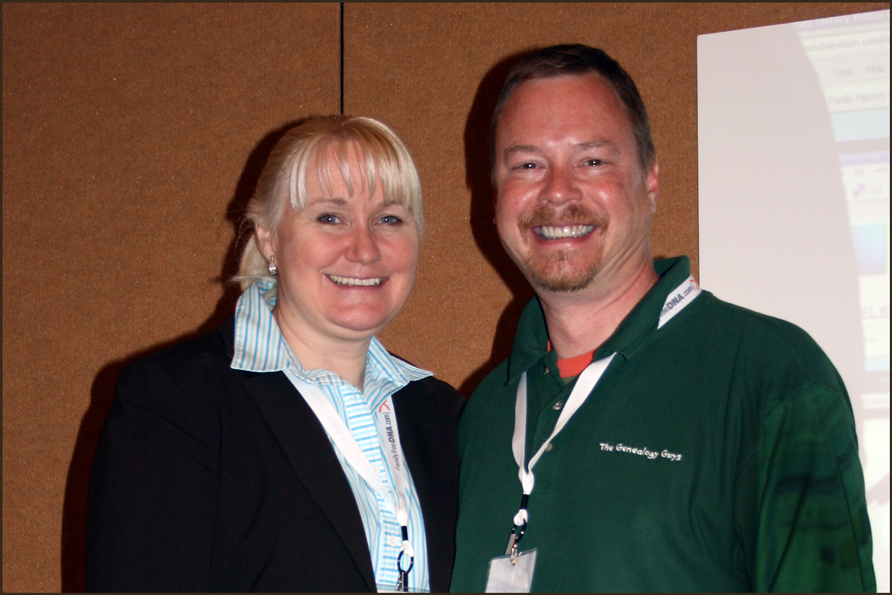While at Jamboree, I had the pleasure of participating in the Genealogy Blogger Summit with Megan Smolenyak and hearing her two presentations on DNA entitled Trace Your Roots with DNA and Beyond Y-DNA: Your Genetic Genealogy Options.
Megan Smolenyak and Steve Danko at Jamboree 2008
SOURCE: Megan Smolenyak and Steve Danko at Jamboree 2008 (Burbank, Los Angeles Co., California). Photographed by Marcy Brown 29 Jun 2008.
Megan defined genetic genealogy as DNA testing for the purpose of learning about one’s heritage and described it as a complement to traditional genealogy.
Of all the DNA tests available, the Y chromosome tests are the most popular. These tests include the test for short tandem repeats (STRs) and the test for single nucleotide polymorphisms (SNPs) on the Y chromosome. The STR test looks for the number of times a particular DNA pattern is repeated at places on the Y chromosome called markers. The results of this test defines a man’s Y chromosomal haplotype.
Since only men have a Y chromosome, women can only participate in this test by proxy, meaning that women must find a male relative (father, brother, uncle, male cousin) to be tested in her place. The Y chromosome is passed on from father to son, and can be used to trace a man’s ancestry from his father’s father’s father’s father. Because the Y chromosome is inherited in this way, analysis of the Y chromosome can be used either to support or disprove relationships.
A second Y-DNA test examines SNPs, mutations in the DNA that are so rare that they are assumed to have occurred only once in human history. The result of SNP tests define a man’s Y chromosomal haplogroup. The haplotype, identified by STR analysis, can be used to predict the haplogroup, and the SNP test can be used to confirm the haplogroup and provide additional details about the haplogroup.
Although only men have a Y chromosome, both men and women have mitochondrial DNA which they inherited from their mothers. Although men have mitochondrial DNA, they do not pass it on to their children. Thus, analysis of the mitochondrial DNA provides a test for one’s mother’s mother’s mother’s mother. Because mitochondrial DNA changes very slowly, it is not quite as useful as Y-DNA to examine relationships among people. Nonetheless, mitochondrial DNA can still be used to support or disprove proposed relationships.
Other DNA tests available to both men and women include tests for ethnic and biogeographic origins. Some of these tests provide percentages of different geographical groups such as Indo-European, Sub-Saharan African, Native American, and East Asian, while others are designed to provide details about African and Native American ancestries.
Still other DNA tests can provide information about inherited medical conditions and physical traits.
Megan pointed out that those who participate in DNA tests often have a specific purpose in mind. Some wish to learn if two people have common origins, while others may wish to uncover connections that paper trails can’t. DNA analysis can help solve personal history mysteries, including cases of uncertain parentage.
Copyright © 2008 by Stephen J. Danko





Great Photo of the two of you!